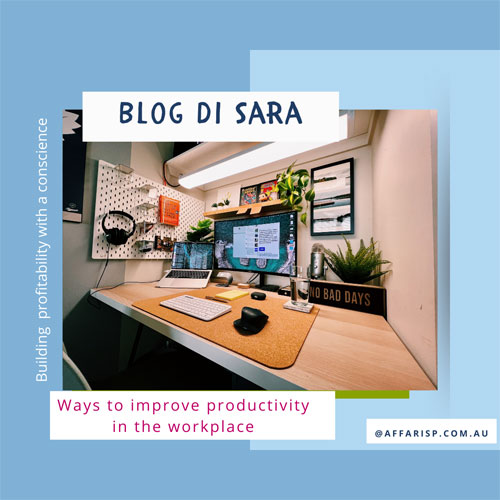Ways to Improve Productivity in the Workplace
The article was written by Sara Pantaleo.
Boosting productivity in your organisation means you will be able to increase profits. Small businesses have twenty employees or fewer. Therefore, it is essential to have strategies to make your business more productive and efficient.
Some of the ways to increase productivity in your small business include tools, systems and processes, and some are about how you build and nurture your employee relationships. If one team member is not performing in a small business, the whole organisation feels the consequences; therefore, it is crucial for small business leaders to also focus on people.
Here are some of the ways to improve productivity in the workplace.
1. Have a purpose, plan and clear goals for the business
Without direction in an organisation and a clear plan, your employees may not be working on tasks that improve or benefit the business. Having clear strategic goals means that each department and employee has a compass on what needs to be achieved and prioritise their tasks to align with the business goals. It is also essential to set and commit to deadlines. Regularly meeting deadlines demonstrates reliability and the ability to stay focused. Customers can be lost if an organisation does not ensure goals are completed on schedule.
2. People Culture and excellent workplace conditions
Develop your employees, offer them support and practice positive reinforcement. Create a culture where employees feel included and that they belong. Employees that believe in the business purpose and vision are more likely to be happy working for you and performing at their peak.
It is also vital to create a well-organised and decorated office, a pleasant workplace to see every day and physically and visually enjoyable. The more comfortable employees feel at the office, the less stressed they will be. One way to maintain a healthy work environment is to create an upbeat atmosphere that makes everyone feel appreciated and motivated.
Every employee doesn’t need to be busy every minute of the entire workday. Keeping your staff too busy can create fatigue and cause burnout. That’s why one of the steps to improve productivity is to take occasional breaks. Taking 10 to 15-minute breaks allows your team to recharge and feel refreshed when they approach the work again.
Try using 90-minute cycles divided by breaks. It’s a practical tip that can lead to higher output. During the 90 minutes, each employee should put as much effort as possible into achieving a task. This is followed by a break to recharge. Creating a flow of 90-minute sessions followed by short breaks is enough time to establish a rhythm and complete tasks without getting burned out.

3. Reduce Distractions
It’s essential to stay focused while working; therefore, remove as many distractions as possible. Remote employees have this advantage, whereas office employees must deal with background noises made by devices and co-workers. Your team in the office should try using soundproof headphones and turning off their personal mobiles unless they are a necessary part of the job.
Avoid booking unproductive meetings that do not have a purpose and do not accomplish much. Like staff meetings. Some topics can be communicated via phone or a quick email.
4. Be Efficient – Track and measure
Most businesses track their financial performance but forget to track and analyse how their team uses their time. Studying the data reveals which employees are productive and which employees need more training. The technology can assist you with communication and performance.
5. Have the right tools, equipment and technology
Technology is an integral part of the modern workplace, and any business without some level of technical savvy will likely fail. Assess that you have the right technology, system, and tools fit for your purpose. There are many cloud-based solutions to achieve different outcomes you may consider. Some of the technology to consider (This list is an indication only):
- An accounting package such as Xero allows you to track your business metrics and performance accurately, keep inventory, make and record sales, manage and pay bills and handle payroll.
- A Client Relationship Manager (CRM) such as Hubspot or Zoho allow you to keep accurate customer data and track your customer’s journey. A CRM will keep you efficient and give you the ability to nurture customers efficiently and without leaving it to chance.
- Software packages that can assist in meeting your employer compliance and facilitate all the templates to help recruit, onboard and train employees, such as Employment Hero.
- Industry-relevant – regardless of your industry, technology makes what you do easier. For example, if you work in health care, countless technologies save lives, protect patient privacy rights, and make sure providers get paid through insurance. On the other hand, if you are a farmer, engineering and robotics will help you maintain crops and improve yield.
- Communications tools such as Slack will allow instant message co-worker communication.
- Social Media – Use Facebook, Instagram and Twitter to communicate directly with your customers. Create and promote your brand and get your message directly to the customer.
- Stay informed with the latest technology and adapt. New and upcoming technologies such as Blockchain[1], AI[2], and IoT[3] are revolutionising business. Stay informed and aware

Being proactive and going beyond what is needed to limit, reduce or eliminate future vulnerabilities is a great strategy. Businesses that don’t take time to proactively prevent future disasters may find themselves in a difficult situation when the disaster occurs. For example, computer networking businesses would take a proactive approach by building a solid defence against cybercriminals.
Consistently assessing how your team works and areas of improvement will help increase overall workplace productivity. While there are various tools out there that aim to streamline workflow, ultimately, as a leader in your organisation, you must be there to support your team.
Forget perfection. It is unrealistic to be perfect in every aspect of your business. Your business can only be as good as your technology and resources.
Footnotes [1] A blockchain is a distributed database that is shared among the nodes of a computer network. As a database, a blockchain stores information electronically in digital format. Blockchains are best known for their crucial role in cryptocurrency systems, such as Bitcoin, for maintaining a secure and decentralized record of transactions. [2] Artificial intelligence (AI) is the capability of a computer system to mimic human cognitive functions such as learning and problem-solving. New level of AI is machine learning, which is the process of using mathematical models of date to help a computer learn without direct instruction. This enables a computer system to continue learning and improving on its own and can solve problems based on experience. [3] The Internet of Things (IoT) describes the network of physical objects—“things”—that are embedded with sensors, software, and other technologies for the purpose of connecting and exchanging data with other devices and systems over the internet.
Ways to Improve Productivity in the Workplace Read More »











